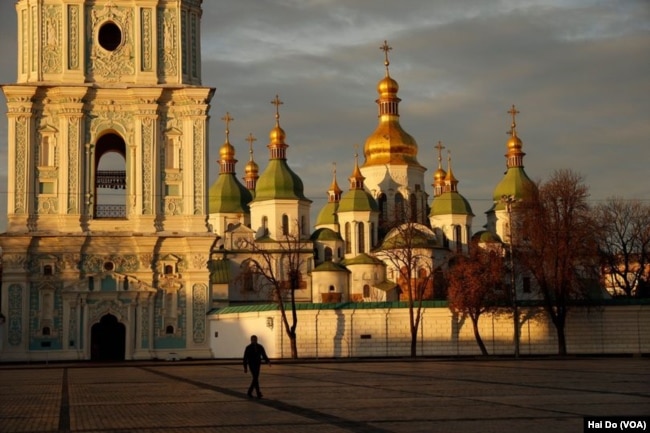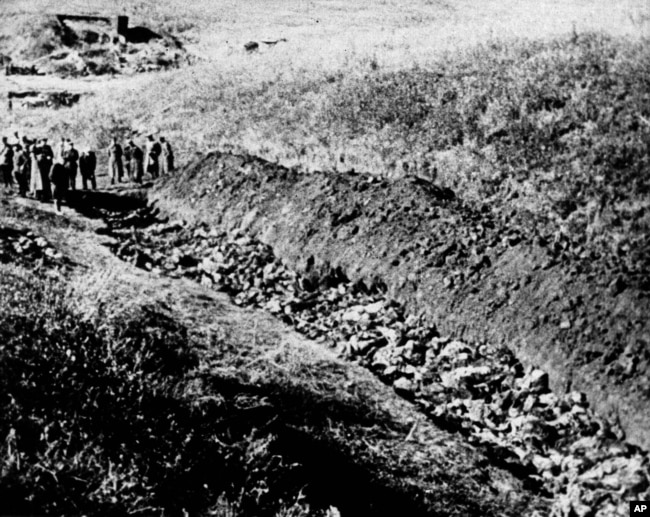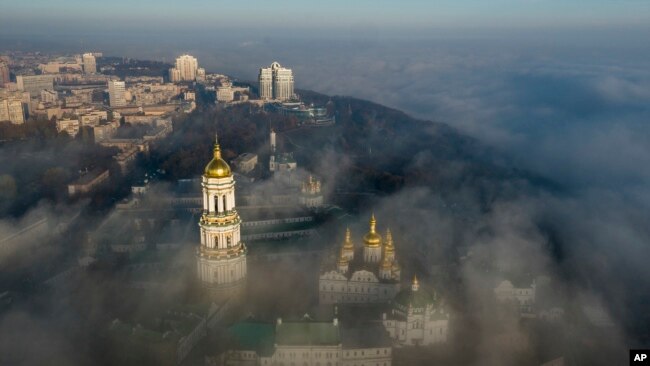キエフ、千年の時が破壊されようとしている!!
1000年の時を刻む古都キエフ!!
ロシアが主張する共通の祖先であるとする国家にある、またロシア正教会にとっても宗教的に重要な場所キエフ。
我々は、この現実を見ているだけなのか?!
平和交渉に向けた世界的な枠組みの英知を信じたい。
ロシアの侵攻でキエフの重要文化財が危機にさらされる(和訳)
Russian Invasion Puts Kyiv’s Important Cultural Places at Risk
Mar 05,2022
ウクライナの首都キエフは、国の文化的・精神的中心地です。しかし、キエフがロシア軍によるさらなる攻撃に備えているため、この街の重要な文化的場所が危険にさらされているのです。
国連の文化機関の責任者であるオードリー・アズレイ氏は火曜日、紛争が続く中、”ウクライナの文化遺産を保護”を呼びかけました。ユネスコは、同国の文化関係者との会議を開催し、重要な場所に国際的に認められた保護のための標識を付けると述べました。
危険にさらされている場所の中には、国内で最も重要な正教会聖堂があります。教会や宗教施設の中には、1000年近い歴史を持つものもあり、それらは、この地域にキリスト教が伝来した当初からあります。
ウクライナ正教とロシア正教の両方にとって、宗教的に重要な場所です。ロシアのプーチン大統領が主張するように、両者が一つの民族の一部であるのか、それともスラブ民族の別個の国家であるのかをめぐる論争において、強力なシンボルとして機能しています。
この地域には、黄金に輝くSt. Sophia’s Cathedral 聖ソフィア大聖堂や、 Kyiv-Pechersk Lavraキエフ・ペチェルスク・ラブラ–修道院として知られる地下と地上の巨大複合施設、も含まれています。その他、聖ミカエル黄金ドーム修道院、聖アンデレ教会などがあります。
火曜日、ウクライナ当局は、ロシア軍がもう一つの記念碑—ウクライナの主要なホロコースト記念碑であるBabi Yarバビ・ヤールを破損したと発表しました。
ロシアが意図的にバビ・ヤールを標的にした形跡はありません。また、ロシアがキエフの聖地を標的にする計画であることも確認されていません。しかし、他の都市ではすでに民間の建物が攻撃されています。
例えば、ウクライナ第二の都市ハリコフにある聖母被昇天大聖堂は、今回の攻撃で被害を受けました。窓ガラスが割られ、その他の部分にも損傷があったといいます。同大聖堂はかつてハリコフで最も高い建物でした。
キエフでのリスクはさらに大きいのです。
「我々は非常に古い都市の話をしているのだ。」とジェイコブ・ラシン氏は言います。彼は、アリゾナ州立大学メリキアン・センターの研究者で、キエフについてこう語っています「中心部は密集しています。たとえ一つのものに当てよううと思っても、簡単に他のものに当たってしまう のです。」
聖堂の象徴的な価値は、その聖堂が関係している宗教を共有していない人々にとっても強力なものです。
「1000年もの間、自分の街にあった主なシンボルが危険にさらされ、破壊されるかもしれないという考えは、非常に恐ろしいものです」とラシン氏は語ります。
バビ・ヤールは、1941年に3万3千人以上のユダヤ人が48時間のうちに殺害された場所です。当時、この街はナチスの占領下にありました。米国ホロコースト記念館によると、これは第二次世界大戦中に一カ所で行われた大量殺戮としては最大級のものだったといいます。
キエフの正教会の聖堂の最も古い部分は、900年代にこの地域がキリスト教化された直後の中世キエフ・ルス王国にさかのぼります。
プーチンは、この王国が現在のロシアとウクライナの共通の祖先であると主張しています。ウクライナ側は、自分たちはスラブ系の隣国から攻撃を受けている独立した国家であると答えています。
この大聖堂や地下宮殿は”人類の創造的才能の最高傑作”とユネスコの世界遺産に登録されています。キエフの大聖堂は約1000年前に建てられ、現代のイスタンブールであるコンスタンチノープルのアヤソフィア教会をモデルにしています。大聖堂には、1000年前の美術品も含まれています。洞窟の修道院は、正教会の普及に影響を与えたとユネスコは述べています。
もし、キエフの施設が損傷したり破壊されたりしたら、「士気が下がる可能性があるのでは?そうだ」とラシン氏は指摘します。「人々の団結力を高める可能性は?もちろんだ」と述べました。
Russian Invasion Puts Kyiv’s Important Cultural Places at Risk
Ukraine’s capital, Kyiv, is the cultural and spiritual heart of the country. But the city’s important cultural places are at risk as Kyiv prepares for more attacks by Russian forces.
On Thursday, the head of the United Nations cultural agency, Audrey Azoulay, called for “protection of Ukrainian cultural heritage” as the conflict continues. UNESCO said it will organize meetings with the county’s cultural officials to mark important places with an internationally recognized sign for protection.
Among the sites at risk are the nation’s most important Orthodox shrines. Some of the shrines, or places of religious observance, are nearly 1,000 years old. They have stood since the early days of Christianity in the area.
The sites are of religious importance to both Ukrainian Orthodox and Russian Orthodox forms of Christianity. They serve as powerful symbols in the dispute over whether the two groups are parts of a single people – as Russian President Vladimir Putin has claimed — or are separate but related ethnic Slavic nations.
The sites include the golden St. Sophia’s Cathedral and the Kyiv-Pechersk Lavra – a huge underground and above-ground complex also known as the Monastery of the Caves. Others include the St. Michael’s Golden-Domed Monastery and St. Andrew’s Church.
On Tuesday, Ukrainian officials said Russian forces damaged another monument — Ukraine’s main Holocaust memorial, Babi Yar.
“What will be next if even Babi Yar (is hit)” asked Ukrainian President Volodymyr Zelenskyy on Wednesday. “What other ‘military’ objects, ‘NATO bases’ are threatening Russia? St. Sophia’s Cathedral, Lavra, Andrew’s Church?”
There is no sign that the Russians targeted Babi Yar on purpose. There is also no confirmation that the Russians plan to target any of the sacred sites in Kyiv. But civilian buildings have already been hit in other cities.
For example, the Assumption Cathedral in Kharkiv, Ukraine’s second-largest city, was damaged in the recent attacks. Its windows were reportedly broken and other parts of the structure were damaged. The cathedral was once Kharkiv’s tallest building.
The risk is even greater in Kyiv.
“We’re talking about a very old city,” said Jacob Lassin. He is a researcher at the Arizona State University’s Melikian Center for Russian, Eurasian, and East European Studies. He said of Kiev, “The center part is densely packed. Even if you’re trying to hit one thing, you could easily hit something else.”
The symbolic value of the shrines is powerful even to people who do not share the religion the shrines are connected to.
“The idea that the main symbol that stood in your city for 1,000 years could be at risk or could be destroyed is very frightening,” Lassin said.
Babi Yar is where more than 33,000 Jews were killed within 48 hours in 1941. At the time, the city was under Nazi occupation. It was one of the largest mass killings at a single place during World War II, the U.S. Holocaust Memorial Museum says.
The oldest parts of Kyiv’s Orthodox Christian shrines date back to the medieval Kievan Rus kingdom, soon after the area became Christian in the 900s.
Putin has claimed that the kingdom is the common ancestor of today’s Russia and Ukraine. Ukrainians answer that they are a separate nation now under attack from a Slavic neighbor.
The cathedral and nearby underground complex represent “a masterpiece of human creative genius,” said a report by UNESCO, which lists both places as World Heritage Sites. The Kyiv cathedral, built about 1000 years ago, was modeled after the Church of Hagia Sophia in Constantinople, modern day Istanbul. The cathedral includes artwork up to 1000 years old. The Monastery of the Caves was influential in spreading Orthodox Christianity, said UNESCO.
If Kyiv’s sites are damaged or destroyed, “could it potentially damage morale? Yes,” Lassin noted. “Could it potentially galvanize people to be more united? …Absolutely,” he stated.
Words in This Story
heritage –n. the traditions, achievements, beliefs, that are part of the history of a group or nation
site –n. the place where something is
symbol –n. a place, action, object, or event, that expresses or represents a particular idea or quality
morale –n. the feelings of enthusiasm and loyalty that a person or group has about a task or job
potentially –adv. possibly
galvanize –v. to cause (people) to become so excited or concerned about an issue, or idea that they want to do something about it


